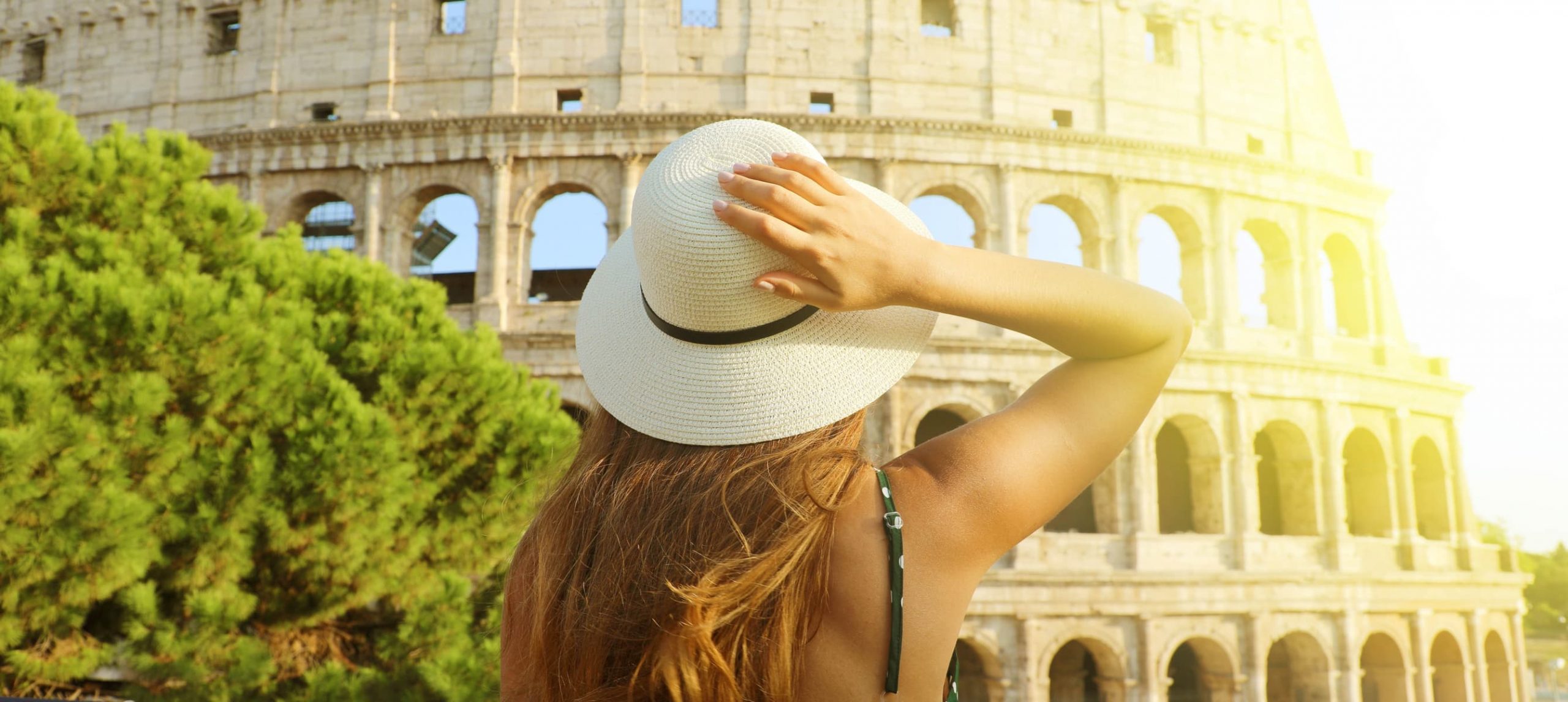The 13 Best Attractions in Rome, Italy
The passing of literal centuries has left Rome with a magnetic charisma that manifests in many interesting ways: cinematic old streets — each with innumerable stories to tell —, history-filled archaeological sites, picture-perfect landmarks, and treasured museums packed with...

The passing of literal centuries has left Rome with a magnetic charisma that manifests in many interesting ways: cinematic old streets — each with innumerable stories to tell —, history-filled archaeological sites, picture-perfect landmarks, and treasured museums packed with unmissable masterpieces by Michelangelo, Caravaggio, and Raphael.
Not to mention the irresistible dolce vita vibe than can be felt from the very first moment while eating gelato in a breezy piazza, or buying freshly fried artichokes at a farmer’s market during springtime.
One of Europe’s most enchanting, and impeccably preserved destinations, Rome boasts plenty of experiences and tourist attractions to take in — even locals haven’t exhausted all there is to do in the city!
With so many delightful options, deciding what to do in Rome can be an overwhelming task. To help you make up your mind, we’ve rounded up the top 13 attractions travelers can’t miss during a trip to the Eternal City. Have a look and get ready for your Italian adventure!
Find Places To Stay In Rome, Italy
The Best Places To Visit In Rome, Italy
The Colosseum

The Colosseum is the perfect starting point for travelers seeking to delve into Rome’s deep and heroic history. Known for its architectural grandeur, this massive oval amphitheater — the largest ancient amphitheater ever built — was erected almost 2,000 years ago under the rule of emperor Vespasian, sometime between 70 and 72 CE, and was completed in 80 AD under his successor, Titus.
A massive freestanding structure made of travertine limestone, concrete, and volcanic rock, the Colosseum had a seating capacity for some 50,000 spectators who went to the amphitheater to watch gruesome combats between gladiators, animal hunts, public executions, and re-enactments of famous battles.
Still, to the present day, the Colosseum is an iconic symbol of Imperial Rome. A guided tour of this spectacular amphitheater will take you to dive deep into its history, and discover some of its most striking features, such as the outer wall made of travertine marble, the arena floor, where gladiator fights were held, and the underground tunnels where gladiators and wild animals were engaged.
Address: Piazza del Colosseo, 1
Opening Hours: Monday to Sunday 9 am to 7:15 pm to
Santa Maria Maggiore

The Basilica of Saint Mary Major or church of Santa Maria Maggiore is an ancient Catholic basilica considered to be the largest of the churches dedicated to the Virgin Mary in Rome.
Perched on the summit of the Esquiline Hill, on the site where the Virgin appeared in a dream of pope Liberius, this major basilica leaves visitors in awe with its 16th-century ceiling gilded with gold, frescoes by Giovanni Baglione, and a gorgeous triumphal arch decorated with splendid mosaics.
Address: Piazza Santa Maria Maggiore, 42
Opening Hours: Daily from 7:00 am to 6:45 pm
Piazza Navona

Built on the remains of the Stadium of Domitian, commissioned around AD 80 by the Emperor Titus Flavius Domitianus as a gift to the people of Rome, Piazza Navona is one of the city’s most dazzling squares. This baroque-style piazza is dotted with three eye-popping fountains — Fontana del Moro, Fontana de ‘Calderari, and the spectacular Fountain of the Four Rivers —, designed during the papacy of Gregory XIII.
Once a site where festivals and sporting events took place, Piazza Navona is now a vibrant square surrounded by ochre-colored mansions, and restaurants, making it the perfect spot for an idle afternoon stroll in Rome!
Address: Piazza Navona
Fontana di Trevi

Every single day, thousands of visitors make their way to Fontana di Trevi only to toss a coin into the fountain. But, aside from potentially granting wishes, this majestic travertine stone construction is also known for its unmistakable beauty that has been dazzling locals and travelers alike since the 18th-century.
Standing 86 ft high and 161.3 ft wide, the Trevi Fountain was built on the site of an ancient aqueduct that dates back to 19 BC. It was designed by Nicola Salvi, in 1732, and completed 30 years later by Giuseppe Pannini, who slightly altered the original scheme.
The centerpiece of the fountain is Pietro Bracci’s statue of Oceanus, who stands atop a chariot pulled by sea horses and is accompanied by tritons. There are also whimsical statues representing Abundance and Health.
Tip: the right way of tossing the coin into the Trevi Fountain is done using your right hand to throw the coin over your left shoulder.
Address: Piazza di Trevi
The Vatican

Religious and cultural sites and some of the world’s most famous art masterpieces make a visit to the Vatican one of the top things to do in Rome. The smallest state in the world by both area and population, the Vatican City is the center of the Roman Catholic Church and the permanent seat of the Popes.
At the center of The Vatican, in St Peter’s Square, lies the majestic St. Peter’s Basilica, which is the second-largest religious building in Christendom. Erected during the 4th-century over the tomb of St. Peter the Apostle, and designed mainly by Donato Bramante, Michelangelo, Carlo Maderno, and Gian Lorenzo Bernini, the basilica is the most renowned work of Renaissance architecture.
Other must-visits include the Vatican Museums, and the otherworldly Sistine Chapel, where visitors are able to see the breathtaking ceiling with large frescoes by Michelangelo, as well as wall paintings by Sandro Botticelli, Domenico Ghirlandaio, and Pietro Perugino.
The Pantheon

Travel back to the glory years of the Roman Empire while visiting the Pantheon, the best-preserved building from ancient Rome. Said to have been created in 125 AD as a temple for the gods, this striking monument is a true architectural marvel with towering, monolithic Corinthian columns made of Egyptian granite, enormous bronze doors, and a dazzling dome that is almost half the length of a football field.
Inside the Pantheon, there are tombs of notable personalities such as Raphael, the painter, and the Renaissance architect.
Address: Piazza della Rotonda
Roman Forum

One of the most famous attractions in Rome, the Roman Forum was once the heart of the city. This multi-purpose site is nestled between the Palatine and Capitoline hills and used to host public meetings, gladiatorial combats, and open-air markets in ancient times. Not by chance, it has been dubbed the most celebrated meeting place in the world, and in all history
While meandering through the site, visitors will come across a plethora of treasured ruins, including the remains of The Temple of Saturn, one of the more significant buildings of the Forum, and other surviving structures such as the Temple of Castor and Pollux, the Temple of the Deified Caesar, the Mamertine Prison, and the Curia (senate house).
Castel Sant’Angelo

Castel Sant’Angelo has been standing majestically on the right bank of the Tiber River, at the end of Ponte Sant’Angelo, for almost 2000 years.
This cylindrical building was initially commissioned by the Roman Emperor Hadrian as a mausoleum for himself and his family but has had several structural and architectural transformations throughout history. Aside from its original purpose of serving as a tomb for the emperor, the mausoleum was later used as a fortress to protect Rome during the Middle Ages, as the pope’s residence, as a prison, and finally, a museum, the Museo Nazionale di Castel Sant’Angelo, which is home to sculptures, architecture, frescoes, and more.
Address: Lungotevere Castello, 50
Arch of Constantine

Sandwiched between the Colosseum and the Palatine Hill, the Arch of Constantine is a massive triumphal arch commissioned by the Roman Senate to commemorate emperor Constantine the Great’s victory over Maxentius at the Battle of Milvian Bridge in AD 312. It is the largest surviving Roman triumphal arch and the last monument of Imperial Rome.
Address: Via di San Gregorio
Villa Borghese

Often regarded as the green lung of Rome, the lush Villa Borghese park was developed in 1606 by Cardinal Scipione Borghese, who wanted to turn his vineyard into the most extensive gardens built in the city. Now, this idyllic park covers 80 verdant hectares dotted with a myriad of marvelous sights, including temples, piazzas, cinemas, and a replica of Shakespeare’s Globe Theater, in London.
No matter what your plans are while visiting Villa Borghese, be sure to visit the Galleria Borghese, home to paintings by Caravaggio, Raphael, Titian, Correggio, Antonello da Messina, and Giovanni Bellini and sculptures by Gian Lorenzo Bernini and Canova.
Address: Piazzale Napoleone I
Palatine Hill

Inhabited since 1000 B.C., Palatine Hill is the centermost of Rome’s Seven Hills and is considered to be the birthplace of Rome. Located 40 meters above the Roman Forum, it contains a wealth of ruins of ancient palaces once created for the high society, including imposing buildings such as the Domus Flavia, built-in 81 B.C. by order of Emperor Domitian as a public and official residence, and House of Augustus, the former private residence of Octavian Augustus.
Curious fact: it is believed that Palatine Hill is the location of the Lupercal (the cave where Romulus and Remus were found by the she-wolf).
Piazza di Spagna & the Spanish Steps

After a day of sightseeing and adventuring yourself into the characterful old streets of Rome, head over to the Spanish Steps for a well-deserved break. This gorgeous Rococo-style staircase of 135 steps rises up from Piazza di Spagna, providing locals and visitors with the perfect spot to eat gelato while indulging in show-stopping views of the city.
Capitoline Museums

Dating back to 1471, when Pope Sixtus IV donated a group of bronze statues of great symbolic value to the People of Rome, the Capitoline Museums are the perfect destination for diving deep into the history of the city. Actually, a single museum containing a group of art and archaeological museums in Piazza del Campidoglio, on top of Capitoline Hill, the site is home to an array of precious treasures, including masterpieces by Caravaggio, Titian, Rubens, and Van Dyck, and works taken from excavations around Rome.
CuddlyNest provides all accommodations to all travelers at the best price. Find unlimited travel inspiration on our blog and social media channels.
You Might Also Like:
Top Italian Dishes You Can Make at Home
The Ultimate Europe Travel Guide
Best Farmers’ Markets in Rome, Italy
What to Pack for a Sustainable Trip To Europe
40 Top & Most Beautiful Castles in Europe

 Koichiko
Koichiko 
































